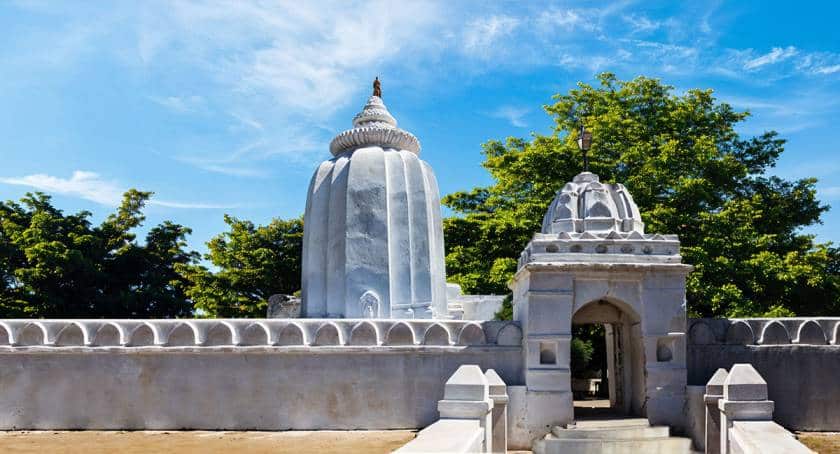The Leaning Temple of Huma, Lord Shiva in Odisha
The Leaning Temple of Huma is an architectural mystery that confounds engineers, historians, and believers alike. It is located in Odisha, India, on the picturesque banks of the Mahanadi River. Dedicated to Lord Shiva, this ancient temple is renowned for its spiritual significance and inexplicable tilt that has defied the test of time. Unlike the Leaning Tower of Pisa, whose tilt has been extensively studied and understood, the Leaning Temple of Huma remains a mystery, with various theories attempting to explain its peculiar inclination. Despite its tilt, the temple has remained structurally stable for centuries, making it a must-visit destination for pilgrims and tourists alike.
The Legend Behind the Leaning Temple
Like most ancient Indian temples, folklore and mythical tales surround the Leaning Temple of Huma, adding to its mystique. In antiquity, an incredible discovery made by a lowly milkman named Kalo is the subject of one of the most well-known myths connected to the temple. According to local beliefs, while offering milk to the river, Kalo noticed that the milk mysteriously disappeared into the water at a particular spot. Upon closer inspection, he discovered a self-manifested Shiva Lingam beneath the river. This divine revelation led to the temple’s construction, and historians believe that King Baliar Singh, the 5th ruler of the Chauhan dynasty of Sambalpur, built it in the 17th century.
Another myth suggests that celestial beings built the temple, which explains its miraculous ability to withstand natural calamities despite its tilted structure. Whether one believes in these legends or not, the temple remains a site of great reverence and spiritual energy.
The Architecture and the Mystery of the Lean
The Leaning Temple of Huma is an architectural marvel comprising several smaller shrines surrounding the main sanctum sanctorum (garbhagriha). The temple complex is home to several minor shrines dedicated to other Hindu deities, adding to its spiritual significance. However, what sets the temple apart is its inexplicable tilt. This phenomenon is even more intriguing because the main temple and the smaller surrounding structures exhibit a similar inclination.
The temple’s lean angle has remained unchanged over centuries, leading experts to believe that the phenomenon might be due to a natural foundation shifting caused by the soft riverbed soil. Some speculate that the temple might have been built with a slight tilt intentionally to counteract any future shifts in the soil, showcasing the advanced engineering skills of ancient Indian builders.
Despite its tilt, the temple has remained structurally sound, having survived floods, earthquakes, and other natural disasters. This has raised numerous questions about the construction techniques used by its ancient builders. Unlike the Leaning Tower of Pisa, which required significant interventions to stabilize its tilt, the Leaning Temple of Huma has no such corrective measures, adding to its mysterious allure.
Scientific Perspectives on the Leaning Phenomenon
Several scientists have conducted studies to understand the reason behind the tilt of the Leaning Temple of Huma. Geologists believe that the temple’s foundation rests on alluvial deposits from the Mahanadi River, which might have led to gradual subsidence, causing the structure to lean over time. However, what perplexes experts is that the tilt has remained constant without further deterioration, defying conventional engineering predictions.
Some experts argue that the temple’s inclination could be due to tectonic plate movements beneath the region, which may have unevenly shifted the land. Others suggest that ancient Indian architects possessed advanced knowledge of soil mechanics and might have deliberately designed the temple with a slight tilt to ensure its longevity in an unstable environment.
Despite these scientific explanations, researchers have not found conclusive evidence to fully explain why the temple leans and has remained stable for centuries. The mystery surrounding its inclination continues to intrigue researchers and visitors alike.
Festivals and Rituals a Hub of Devotion
The Leaning Temple of Huma remains an important pilgrimage site for Shiva devotees, attracting thousands of worshippers annually. The temple is exceptionally crowded during Maha Shivaratri, a significant Hindu festival dedicated to Lord Shiva. People from all over the nation come to pray and ask for favors. The temple features beautiful decorations, and devotees perform religious rituals with great devotion, including elaborate poojas and abhishekas.
Another major festival celebrated at the temple is Bada Osha, which takes place on Kartik Purnima (the whole moon night of the Kartik month). The festival is marked by grand celebrations, processions, and special prayers, drawing devotees and tourists alike. During this time, the temple premises became a religious fervor hub, with devotees fasting and participating in rituals to seek divine blessings.
One of the unique aspects of the temple’s surroundings is the presence of Kudo fish in the Mahanadi River. Devotees consider these fish sacred and believe that feeding them brings good fortune. Interestingly, locals and tourists never catch the fish, as they regard them as divine entities that add to the temple’s spiritual ambiance.
Final Thoughts
The Leaning Temple of Huma is a place of worship and a symbol of India’s rich architectural and cultural heritage. Its mysterious tilt, centuries of devotion, and scientific curiosity make it a fascinating destination for spiritual seekers and history enthusiasts. Whether you are an ardent devotee of Lord Shiva or an explorer intrigued by architectural marvels, this temple promises an unforgettable experience steeped in history, mystery, and divinity.
With its enigmatic lean, the temple continues to inspire awe and wonder, standing as a testament to the ingenuity of ancient Indian builders. Gazing upon the leaning structure against the backdrop of the mighty Mahanadi River reminds one of the enduring power of faith and the mysteries that history still holds. The Leaning Temple of Huma is an experience of architectural genius and spiritual enlightenment that makes a lasting impression on the soul.


